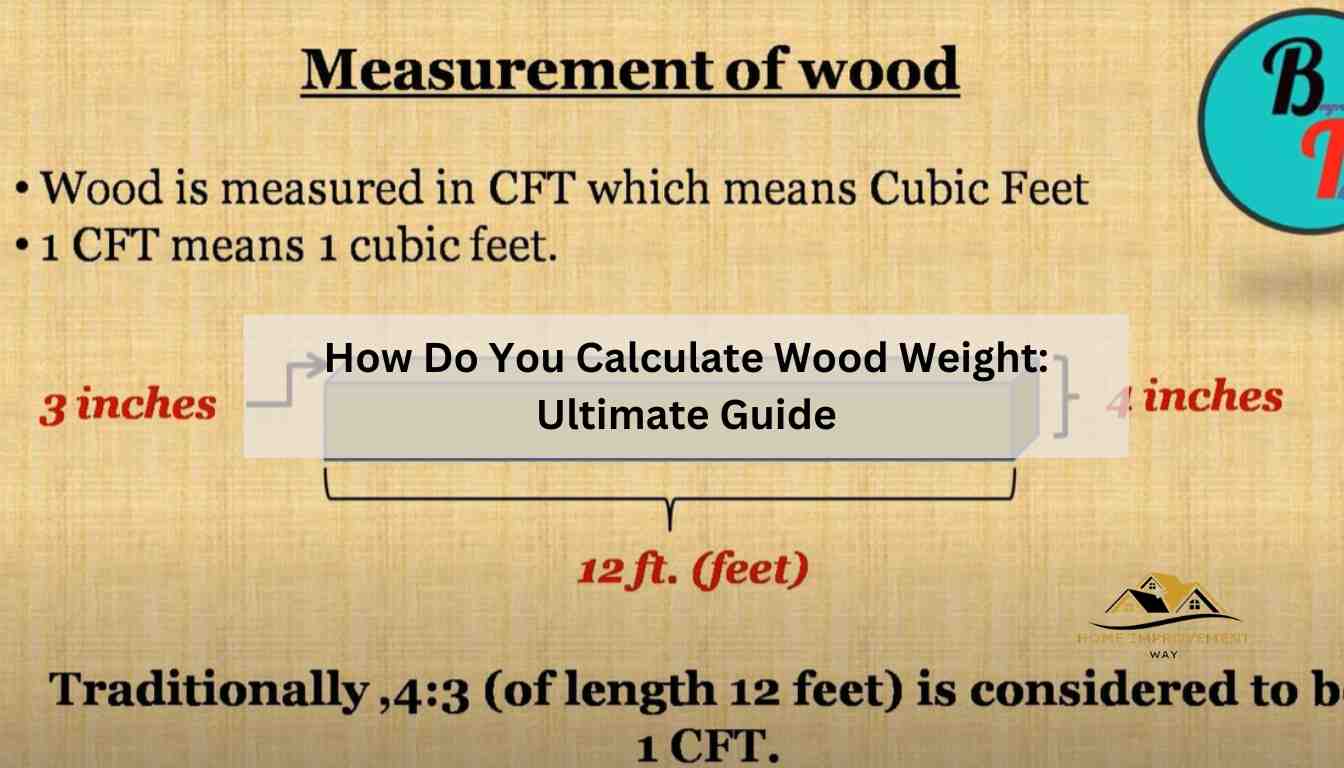How Do You Calculate Wood Weight: Ultimate Guide
To calculate the weight of wood, multiply its volume by its density. This will give you the weight in pounds or tons.
When estimating a wood’s weight, factors like moisture content and type of wood should also be considered. Understanding how to calculate wood weight is essential for various applications, such as determining load capacity, transportation, and construction. Whether you are a carpenter, furniture maker, or a lumber supplier, knowing the weight of wood is crucial in ensuring safety and efficient planning.
By using the correct formula and considering other important variables, you can accurately determine the wood’s weight and make informed decisions in your woodworking or construction projects.

Credit: www.lektowoodfuels.co.uk
Introduction To Calculating Wood Weight
Understanding the weight of wood is crucial for various applications, such as construction, transportation, and woodworking. Calculating wood weight allows for efficient planning and resource management. There are different methods to determine the weight of wood, each serving specific purposes based on the intended use.
Why Calculate Wood Weight?
Calculating wood weight is essential for accurate project planning, determining the load-bearing capacity of structures, and ensuring safety in transportation. Understanding the weight of wood helps in estimating the amount of raw materials needed for a project, reducing wastage and cost overruns.
Importance Of Calculating Wood Weight
Knowing the weight of wood is critical for architects, engineers, and builders to design and construct structures that can safely support the load without compromising structural integrity. It also plays a significant role in determining transportation logistics, ensuring that weight limits for vehicles are not exceeded.
Different Methods Of Calculating Wood Weight
There are several methods to calculate wood weight, including using wood density algorithms in real-time calculators, referring to weight comparison charts, and using simple formulas that consider wood volume and density. Each method offers specific advantages based on the project requirements and available resources.
Formula For Calculating The Weight Of Lumber
Determining Board Footage
Calculating lumber weight begins with determining the board footage, which is a standard measuring unit in the lumber industry. You can calculate board footage using the formula:
- Width (in inches) x Length (in feet) x Thickness (in inches) = Board Feet
- For example, a board measuring 6 inches in width, 8 feet in length, and 2 inches in thickness would be calculated as follows: 6 x 8 x 2 = 96 board feet.
Air Dried Vs Kiln Dried Lumber
The weight of lumber can vary based on whether it is air dried or kiln dried. Air-dried lumber contains more moisture, resulting in a heavier weight compared to kiln-dried lumber, which has a lower moisture content. Therefore, it’s crucial to consider the drying method when calculating lumber weight.
Calculating Weight Using The Formula
The formula for calculating the weight of lumber is:
- Weight (in pounds) = Volume (in board feet) x Wood Density (in pounds per board foot)
- For instance, if the volume of the lumber is 100 board feet and the wood density is 35 pounds per board foot, the weight calculation would be: 100 x 35 = 3,500 pounds.
Estimating The Weight Of Logs
To estimate the weight of logs, calculate the board footage and use a formula that takes into account the log diameter, length, and type of wood. Another method is to calculate the weight of a specific slab by multiplying the wood density by the volume.
You can also use online lumber weight calculators that consider wood density to accurately determine the weight of timber.
Log Diameter And Length
One of the key factors in estimating the weight of logs is their diameter and length. The larger the diameter and longer the log, the heavier it will be. To calculate the weight, you need to measure or estimate the log’s diameter in inches (A) and its length in feet (B).
Type Of Wood Value
The type of wood also plays a role in determining the weight of logs. Different wood species have varying densities, which directly affects their weight. When estimating the weight, you’ll need to assign a value (C) to represent the specific wood species or consult a trusted log weight chart.
Using The Log Weight Chart
To simplify the process of estimating log weight, you can use a log weight chart. These charts provide approximate weight values based on the log’s diameter, length, and wood species. By referring to the chart, you can quickly determine the weight of a log without the need for complex calculations.
| Log Diameter (inches) | Log Length (feet) | Type of Wood | Weight (lbs) |
|---|---|---|---|
| 12 | 8 | Oak | 480 |
| 18 | 10 | Pine | 780 |
| 24 | 12 | Maple | 1240 |
Using a log weight chart, you can cross-reference the log’s diameter, length, and wood species to find its estimated weight. This valuable tool saves you time and provides accurate weight estimates for different types of logs.
In conclusion, estimating the weight of logs involves considering their diameter, length, and type of wood. A log weight chart can help provide quick and reliable weight estimates without the need for complex calculations.
Calculating The Weight Of Live Edge Slabs
Wood density is crucial in determining the weight of live edge slabs. Find the specific density of the wood species you are working with.
Measure the length, width, and thickness of the live edge slab to calculate its volume. Use a suitable formula based on the shape of the slab.
Now, multiply the wood density by the volume of the live edge slab to get an accurate estimate of its weight. The formula is weight = density x volume.
Determining The Total Weight Of Lumber
Number Of Pieces Of Lumber
To calculate the total weight of lumber, first determine the number of pieces needed.
Weight Of A Single Piece Of Lumber
Next, find out the weight of a single piece of lumber.
Multiplying To Find The Total Weight
Once you have the weight of a single piece and the total number of pieces, multiply them to get the total weight.
Using Wood Density Algorithm To Calculate Weight
Calculating the weight of wood is essential for various purposes in the woodworking industry. Whether you are a professional carpenter or an avid DIY enthusiast, accurately estimating the weight of timber is crucial for project planning and load-bearing capacity. One of the most reliable methods to calculate wood weight is by using a wood density algorithm.
This algorithm takes into account the density of the wood species and the volume of the wood, providing an accurate weight measurement. In this section, we will explore the process of calculating wood weight using a wood density algorithm.
Introduction To Wood Density Algorithm
The wood density algorithm is a mathematical formula that considers the density of different wood species to calculate their weight. Each wood species has a unique density, which is typically expressed in pounds per cubic foot. By multiplying the density with the volume of wood, we can determine its weight.
Using A Wood Weight Calculator
Utilizing a wood weight calculator simplifies the process of calculating wood weight using the density algorithm. These calculators are designed to handle different wood species and provide accurate results. To use a wood weight calculator:
- Enter the species of wood you are working with.
- Measure or estimate the volume of the wood in cubic feet. This can be done by multiplying the length, width, and height of the wood.
- Input the measurements into the wood weight calculator.
- The calculator will use the wood density algorithm to calculate the weight of the timber.
By using a wood weight calculator, you can quickly and accurately determine the weight of any piece of wood, helping you make informed decisions during your woodworking projects.
Calculating Weight Of Timber
To calculate the weight of timber manually using the wood density algorithm, follow these steps:
- Identify the density of the wood species you are working with. This information can usually be found in wood density charts or online resources.
- Measure or estimate the volume of the wood in cubic feet.
- Multiply the density of the wood species by the volume of the wood.
- The result will be the weight of the timber in pounds.
It’s important to note that wood density may vary within a single species. Factors such as moisture content and growth conditions can affect the actual weight of the wood. However, using the wood density algorithm provides a reasonable estimate for project planning purposes.
Calculating Wood Weight In Tons
To calculate wood weight in tons, multiply the volume of wood in cubic feet by its density. The weight formula for wood is weight (in tons) = volume (in cubic feet) x density. This method helps in determining the weight of lumber accurately for various applications.
Volume Multiplied By Density
Calculating wood weight in tons involves multiplying the volume of the wood by its density. The formula for this calculation is:
Weight (in tons) = Volume (in cubic feet) x Density (in pounds per cubic foot)
Converting To Tons
Once you have the weight calculated using the formula, you can convert it to tons. To do this, simply divide the weight in pounds by 2000, as there are 2000 pounds in a ton.
How To Use Quora For Weight Calculations
If you’re looking to calculate the weight of wood using specific examples, Quora can be a helpful resource. The weight of wood can be calculated in tons by multiplying its volume by its density.

Credit: www.anstertrailer.com
Calculating Wood Weight Using Lumber Moisture Content
Determining Moisture Content
Before calculating wood weight using lumber moisture content, you need to determine the moisture content of the wood. The moisture content is crucial as it directly affects the weight of the wood. To measure the moisture content, you can use a moisture meter which gives an accurate reading.
Alternatively, you can use a simple method of weighing the wood before and after drying to calculate the moisture content. The formula for determining moisture content is the initial weight of the wood minus the weight after drying, divided by the weight after drying, multiplied by 100 to get the percentage moisture content.
Using The Lumber Weight Calculator
Once you have determined the moisture content, you can use a lumber weight calculator to calculate the weight of the wood. The calculator takes into account the species of wood, the volume, and the moisture content to provide an accurate weight measurement. By inputting these variables into the calculator, you can obtain the precise weight of the wood, taking into account its moisture content.
Impact Of Moisture Content On Weight
The moisture content of wood has a significant impact on its weight. As the moisture content decreases, the weight of the wood also decreases. This is because water is heavy and contributes to a major portion of the wood’s weight. Therefore, when the wood is dried, its weight reduces as the moisture content decreases. Understanding the impact of moisture content on wood weight is essential for various applications, including construction, woodworking, and transportation.

Credit: www.lektowoodfuels.co.uk
Frequently Asked Questions For How Do You Calculate Wood Weight
How Much Does A 2×4 Weigh?
A 2×4 typically weighs around 10 to 17 pounds, depending on the type of wood used.
How Much Does 30 Yards Of Wood Weigh?
30 yards of wood weighs approximately X pounds.
How Do You Weigh Lumber?
To weigh lumber, use this formula: (Board footage) x (Wood density) = Weight in pounds. Measure or estimate board footage and multiply by wood density. For specific weight, find wood density and multiply by volume. Multiple pieces can be calculated by multiplying weight of a single piece.
How Do I Figure Out How Much A Log Weighs?
To figure out how much a log weighs, use this formula: Log Weight (lbs) = (Diameter (in) – 4) ^ 2 x Length (ft) x Specific Gravity / 3. Create a specific gravity chart for common wood types. Be aware that this formula is an estimate.
Conclusion
In order to calculate the weight of wood accurately, it is essential to consider its volume and density. By multiplying the volume and density, one can determine the weight of the wood. This calculation can be especially useful when it comes to estimating the weight of lumber or logs.
By following this simple formula, individuals can easily calculate the weight of wood and make informed decisions regarding their projects.







